If you think octopuses are just squishy sea creatures with eight legs, think again! These animals are some of the smartest and sneakiest beings in the ocean. Not only are they clever, but they also have a huge toolbox of tricks to stay alive. In this post, we’ll explore the amazing octopus survival tactics that help them outwit predators and live another day. Get ready for a deep dive into the magical, mysterious world of octopuses.
Contents
Why Do Octopuses Need Survival Tactics?🐟
To begin with, octopuses live in oceans full of danger. They don’t have bones, claws, or even a hard shell like turtles. So, how do they survive? That’s right—they get creative! Looking for a delicious way to enjoy ocean treasures? Don’t miss our 5 recipes with Amatista fish for a flavorful adventure.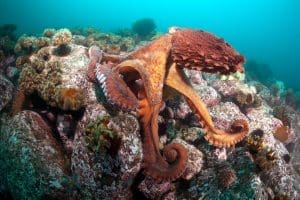
Their Enemies
Here are some of the creatures that would love to eat an octopus:
- Sharks
- Dolphins
- Bigger fish
- Eels
- Even other octopuses!
Since danger is always nearby, they need smart ways to escape and hide. And guess what? They have some of the best survival strategies in the animal kingdom.
Houdini of the Sea: Amazing Escape Artists🐟
Now that we know why octopuses need to be careful, let’s see how they escape trouble.
1. Color-Changing Skin
Thanks to tiny color cells in their skin, octopuses can change color in an instant. They blend into rocks, sand, coral—almost anything!
- Want to look like seaweed? No problem.
- Need to look like a rock? Easy peasy.
This makes them almost invisible to predators. Even better, it helps them sneak up on prey!
2. Inky Getaway
Another cool trick? Ink clouds. When an octopus feels threatened, it squirts a dark cloud of ink into the water. This:
- Confuses enemies
- Blocks their view
- Smells bad to some predators
Then the octopus makes a quick getaway while the predator is left in the cloud thinking, “Wait, where did it go?!”
3. Squeezing Through Tiny Spaces
Because octopuses have no bones, they can slip through super tiny cracks and holes. If their beak can fit, the rest of their body can too! That means they can: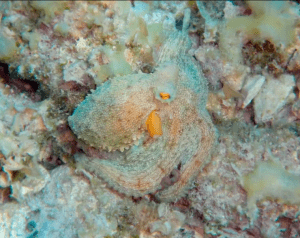
- Escape predators
- Hide in tiny spaces
- Surprise prey from inside cracks
This is one of the most impressive octopus survival tactics.
Hide and Don’t Seek: Mastering Camouflage🐟
Moving on, let’s talk about how octopuses are camouflage experts. This means they can hide without being seen, even in plain sight!
1. Mimicking Other Animals
Some octopuses go a step further than blending in. They pretend to be other animals! For example:
- The mimic octopus can look like a lionfish, sea snake, or flatfish.
- It moves its arms and changes color to copy other sea creatures.
Why is this smart? Because predators might leave them alone if they look dangerous or poisonous.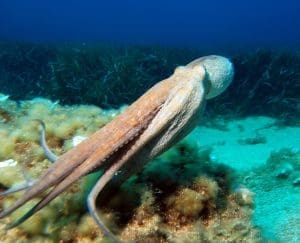
2. Shapeshifting
Octopuses don’t just change color—they change shape too. They can puff up to look bigger, shrink down to look small, or stretch out to look flat.
This lets them:
- Look scary
- Fit in tight spots
- Trick predators into thinking they’re something else
It’s like ocean magic!
Brains and Brawn: Outthinking the Ocean🐟
It’s not all about looks, though. Octopuses also use their big brains to stay alive. In fact, they are some of the smartest invertebrates in the world! If you love discovering hidden wonders, explore our guide to Secluded Isles: Nature’s Secret Hideaways You Must Explore.
1. Problem Solving
Octopuses can open jars, solve mazes, and learn from experience. Scientists have even seen them: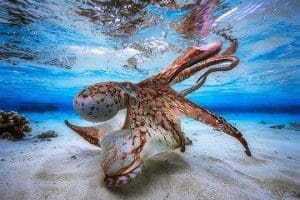
- Use coconut shells as shields
- Collect rocks to block cave entrances
- Escape aquariums (seriously!)
This intelligence helps them solve problems quickly, like how to escape traps or how to sneak up on a crab.
2. Learning and Memory
Not only do they figure things out—they remember them. Octopuses can:
- Learn from watching others
- Avoid things that hurt them
- Recognize humans and other animals
This means they’re not just reacting—they’re thinking.
Babies in Trouble: How Young Octopuses Survive🐟
So far, we’ve talked about adult octopuses. But what about the babies? Believe it or not, they have to rely on their own mini survival skills too.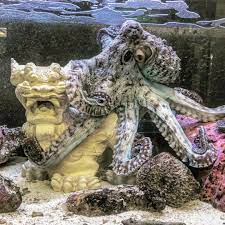
1. Floating and Hiding
Octopus babies, or larvae, float near the surface at first. They are super tiny and try to:
- Stay still
- Hide among plankton
- Avoid being seen
It’s a dangerous time, and only a few grow up to be adults.
2. Early Camouflage
Even as babies, octopuses start practicing camouflage. They learn how to change color, how to hide in sand, and how to run away fast.
Survival starts early when you’re an octopus!
Fun Fact Break! (Because You Deserve It)🐟
Here are some cool, quick facts to impress your friends:
- An octopus has three hearts.
- It can regrow a lost arm.
- Some species can survive out of water for a short time!
Final Thoughts: A True Ocean Ninja🐟
To wrap things up, octopuses are not just weird-looking sea animals. They are creative, clever, and full of surprises. Their survival tactics are so cool that even humans can learn a thing or two about staying calm, thinking smart, and blending in when needed!
So next time you see an octopus in a nature show or aquarium, remember: you’re looking at one of the ocean’s most impressive escape artists.

